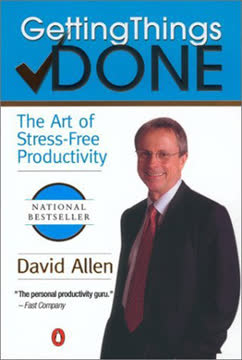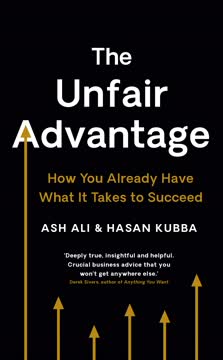Key Takeaways
1. Master the Rule of 3 for focused productivity
The Rule of 3 will help you stay focused on the vital few things that matter.
Simplify and prioritize. The Rule of 3 is the cornerstone of Agile Results, encouraging you to identify three key outcomes for your day, week, month, and year. This practice helps you cut through the noise of endless to-do lists and focus on what truly matters. By limiting your focus to three items, you reduce overwhelm and increase your chances of actually accomplishing your goals.
Flexibility and fresh starts. Each day offers a new opportunity to apply the Rule of 3, allowing you to adapt to changing priorities and circumstances. This flexibility ensures that you're always working on the most important tasks, rather than being tied to an outdated list. The Rule of 3 also scales effectively:
- Daily: Three outcomes to guide your actions
- Weekly: Three key results to shape your focus
- Monthly: Three objectives to drive progress
- Yearly: Three significant achievements to aspire towards
2. Implement the Monday Vision, Daily Outcomes, Friday Reflection pattern
Monday Vision, Daily Outcomes, Friday Reflection is a simple but effective pattern for results.
Structure your week. This pattern provides a rhythm for your week, ensuring that you start with clarity, maintain focus, and end with reflection:
- Monday Vision: Set three key outcomes for the week
- Daily Outcomes: Identify three results to achieve each day
- Friday Reflection: Review what went well and areas for improvement
Continuous improvement. By bookending your week with vision-setting and reflection, you create a feedback loop that allows for constant refinement of your approach. The daily outcomes keep you on track, while the weekly review helps you learn from your experiences and adjust your strategies accordingly.
3. Balance life through Hot Spots: mind, body, emotions, career, financial, relationships, fun
Hot Spots help shine the spotlight on things that are important.
Holistic approach to life. The Hot Spots framework encourages you to invest your time and energy across seven key areas of life: mind, body, emotions, career, financial, relationships, and fun. This balanced approach ensures that you're not neglecting important aspects of your life while pursuing success in others.
Set boundaries and allocate resources. Use the Hot Spots to:
- Identify areas that need more attention
- Set minimum and maximum time investments for each area
- Create a visual "heat map" of your life to guide decision-making
- Recognize the interconnectedness of these areas and how they support each other
4. Prioritize outcomes over activities for meaningful results
Outcomes are the results you want to accomplish.
Focus on impact. Shift your mindset from simply completing tasks to achieving meaningful outcomes. This approach helps you:
- Clarify what success looks like
- Make better decisions about where to invest your time and energy
- Avoid busy work that doesn't contribute to your goals
Align daily actions with larger objectives. By focusing on outcomes, you create a clear line of sight between your daily activities and your long-term goals. This alignment helps maintain motivation and ensures that your efforts are contributing to meaningful progress.
5. Adopt a growth mindset and embrace continuous learning
Change your mindset to embrace change.
Cultivate resilience. A growth mindset is the belief that your abilities and intelligence can be developed through effort, learning, and persistence. This mindset is crucial for:
- Overcoming challenges and setbacks
- Embracing new opportunities for learning and growth
- Adapting to changes in your environment
Continuous improvement strategies:
- Treat failures as learning opportunities
- Seek feedback and act on it
- Set challenging goals that stretch your abilities
- Embrace the discomfort of learning new skills
6. Leverage time, energy, and technique for optimal performance
Your best results will be the intersection of your time, energy, and techniques.
Optimize your resources. Recognize that productivity is not just about managing time, but also about:
- Energy management: Identify your peak performance hours and align important tasks accordingly
- Technique refinement: Continuously improve your methods and approaches
Strategic allocation. Consider these factors when planning your work:
- Time: Use timeboxing and set clear boundaries
- Energy: Schedule high-impact tasks during your "power hours"
- Technique: Invest in learning and refining effective methods for common tasks
7. Cultivate motivation through compelling "Whys" and positive mindsets
Passion is your fuel.
Harness intrinsic motivation. Develop a compelling "Why" for your goals and projects. This internal drive will:
- Sustain you through challenges
- Provide clarity in decision-making
- Increase your overall satisfaction and engagement
Positive mindset strategies:
- Reframe challenges as opportunities for growth
- Use empowering metaphors to describe your work and life
- Practice gratitude and celebrate small wins
- Surround yourself with supportive and inspiring people
8. Design your day, week, month, and year for sustainable success
Designing your day is a simple exercise in creating enough scaffolding for your day.
Intentional planning. Take control of your time by designing your:
- Day: Start with a clear vision of your three key outcomes
- Week: Use the Monday Vision, Daily Outcomes, Friday Reflection pattern
- Month: Set broader goals and review progress regularly
- Year: Identify three significant achievements to work towards
Create supportive routines. Develop:
- A startup routine to begin your day with focus and energy
- A shutdown routine to transition effectively from work to personal time
- Regular review and planning sessions to stay on track
9. Utilize solution-focused questions to overcome challenges
Solution-focused questions help find a way forward.
Shift perspective. Instead of dwelling on problems, train yourself to ask questions that lead to solutions:
- "What's the next best thing I can do?"
- "How can I make the most of this situation?"
- "What would success look like in this scenario?"
Problem-solving approach:
- Clearly define the desired outcome
- Brainstorm potential solutions without judgment
- Evaluate options based on feasibility and impact
- Choose and implement the best solution
- Review and adjust as needed
10. Harness the power of metaphors and mindsets to shape your experience
Metaphors shape your experience.
Choose empowering mental models. The metaphors and mindsets you adopt significantly influence your thoughts, feelings, and actions. Consciously select:
- Metaphors that inspire and motivate you
- Mindsets that promote growth and resilience
Practical applications:
- Reframe challenges: "This is not a setback, it's a setup for a comeback"
- Adopt role-based thinking: "I'm the director of my life story"
- Use nature-inspired metaphors: "I'm weathering the storm" or "I'm planting seeds for future success"
- Switch between different "hats" or personas to tackle various tasks effectively
Last updated:
FAQ
1. What is "Getting Results the Agile Way" by J.D. Meier about?
- Personal Results System: The book introduces Agile Results, a personal productivity system designed to help individuals achieve meaningful results in work and life.
- Agility and Adaptability: It emphasizes adaptability, enabling readers to respond effectively to change rather than being managed by it.
- Outcome-Focused Approach: The system prioritizes outcomes over activities, encouraging readers to focus on what truly matters rather than just being busy.
- Holistic Life Balance: Agile Results integrates principles from productivity, project management, positive psychology, and agile software development to help readers balance work, personal life, and well-being.
2. Why should I read "Getting Results the Agile Way" by J.D. Meier?
- Simple, Actionable Framework: The book offers a straightforward, easy-to-implement system that can be adopted in under five minutes and tailored to individual needs.
- Work-Life Balance: It provides practical tools for achieving sustainable results while maintaining balance across key life areas like mind, body, emotions, career, finances, relationships, and fun.
- Continuous Improvement: Readers learn how to continuously improve their productivity and effectiveness through reflection and incremental changes.
- Proven in Real-World Scenarios: The system has been tested in high-pressure environments, including Microsoft, and is designed to scale for both individuals and teams.
3. What are the key takeaways from "Getting Results the Agile Way"?
- The Rule of 3: Focus on three key outcomes each day, week, month, and year to maintain clarity and avoid overwhelm.
- Monday Vision, Daily Outcomes, Friday Reflection: Use this weekly pattern to set intentions, prioritize daily actions, and reflect on progress for continuous improvement.
- Hot Spots: Identify and invest in the most important areas of your life to achieve balance and maximize results.
- Emphasis on Energy and Technique: Managing energy and using effective techniques are as important as managing time for achieving results.
4. How does the Agile Results system by J.D. Meier differ from other productivity systems?
- Agility Over Rigidity: Unlike static systems, Agile Results is designed to be flexible and responsive to change, allowing for course corrections as needed.
- Outcomes Over Activities: The system shifts focus from checking off tasks to achieving meaningful results, ensuring efforts align with personal and professional goals.
- Time as a First-Class Citizen: It encourages fixing time and flexing scope, rather than endlessly expanding work hours to get more done.
- Fresh Start Philosophy: Agile Results offers a fresh start each day, week, month, and year, making it easy to recover from setbacks and maintain momentum.
5. What is "The Rule of 3" in "Getting Results the Agile Way" and how do I use it?
- Core Practice: The Rule of 3 is the foundational practice of Agile Results, guiding you to identify three key outcomes for each day, week, month, and year.
- Clarity and Focus: By limiting your focus to three priorities, you avoid overwhelm and ensure attention is given to what matters most.
- Scalable Application: The Rule of 3 can be applied at different levels—daily, weekly, monthly, yearly—to maintain perspective and alignment.
- Incremental Progress: Once your three outcomes are achieved, you can always take on more, but the system encourages starting with a manageable scope.
6. What is the "Monday Vision, Daily Outcomes, Friday Reflection" pattern in Agile Results?
- Weekly Rhythm: On Mondays, set your vision by identifying three key outcomes for the week; each day, choose three outcomes to focus on; on Fridays, reflect on what went well and what needs improvement.
- Self-Correcting System: This pattern provides regular opportunities for course correction, learning, and adaptation.
- Reduces Overwhelm: By focusing on a small set of priorities, you avoid long, unmanageable to-do lists and stay engaged with your goals.
- Builds Momentum: The routine helps you build habits, maintain motivation, and celebrate progress, making it easier to sustain results over time.
7. What are "Hot Spots" in "Getting Results the Agile Way" and how do they help with work-life balance?
- Key Life Areas: Hot Spots are the most important areas of your life—mind, body, emotions, career, financial, relationships, and fun—that require your attention and investment.
- Personal Heat Map: They act as a heat map, helping you quickly identify opportunities and pain points across your life.
- Portfolio Approach: By viewing your life as a portfolio of Hot Spots, you can allocate time and energy more thoughtfully, avoiding over-investment in one area at the expense of others.
- Setting Boundaries: Hot Spots help you set minimums and maximums for each area, supporting sustainable work-life balance and preventing burnout.
8. What are the 10 values, 10 principles, and 12 core practices of Agile Results?
- 10 Values: These include Action over Analysis Paralysis, Energy over Time, Focus over Quantity, Good Enough over Perfection, Growth Mindset over Fixed Mindset, and more, guiding decision-making and trade-offs.
- 10 Principles: Principles such as 80/20 Action, Change Your Approach, Continuous Learning, Deliver Incremental Value, and Fix Time, Flex Scope provide foundational guidelines for behavior.
- 12 Core Practices: Practices like The Rule of 3, Monday Vision/Daily Outcomes/Friday Reflection, Scannable Outcomes, Strong Week, Timebox Your Day, and Growth Mindset translate values and principles into daily action.
- Flexible Adoption: You can adopt these practices incrementally, tailoring the system to your needs and context.
9. How do I design my day, week, month, and year using Agile Results?
- Day: Start with The Rule of 3 to set three outcomes, create a startup routine, scan your Hot Spots, and end with reflection.
- Week: Use Monday Vision to set weekly outcomes, consolidate strengths and weaknesses, schedule free time, and reflect on Fridays.
- Month: Map out your month at a glance, prioritize outcomes using MUST, SHOULD, COULD, and assign top priorities to each week.
- Year: Identify three great results or "wishes" for the year, create a scannable year-at-a-glance, and align monthly and weekly outcomes to support your annual goals.
10. What are the most common productivity pitfalls and personas described in "Getting Results the Agile Way"?
- Productivity Pitfalls: Common pitfalls include analysis paralysis, perfectionism, lack of boundaries, doing it only when you feel like it, and not knowing the work to be done.
- 30 Pitfalls Listed: The book details 30 pitfalls, such as burnout, blamer/victim mentality, lack of buffer, and watching the scoreboard instead of focusing on actions.
- Productivity Personas: Personas like Starter, Finisher, Thinker, Doer, Simplifier, Maximizer, Perfectionist, and Procrastinator help you understand your own and others' behavior patterns.
- Self-Awareness Tool: Recognizing these pitfalls and personas enables you to make better choices, team up effectively, and avoid common traps.
11. What are the 25 keys and 25 strategies for results in "Getting Results the Agile Way"?
- 25 Keys: These are foundational concepts such as Results over Productivity, Approach over Results, Value is in the Eye of the Beholder, Time/Energy/Technique, and Above the Line vs. Below the Line work.
- 25 Strategies: Strategies include Outcomes over Activities, Treat Time as a Valuable Resource, Fix Time/Flex Scope, Diversify Your Results, Make It a Project, Have a Strong Week, and Enjoy the Process.
- Actionable Guidance: Each key and strategy provides practical advice for improving effectiveness, efficiency, and personal satisfaction.
- Mix and Match: Readers are encouraged to familiarize themselves with these and draw on them as needed to overcome challenges and achieve goals.
12. What are the best quotes from "Getting Results the Agile Way" by J.D. Meier and what do they mean?
- "Notice that the stiffest tree is most easily cracked, while the bamboo or willow survives by bending with the wind." —Bruce Lee: Emphasizes the importance of adaptability and flexibility in achieving results.
- "You see, in life, lots of people know what to do, but few people actually do what they know. Knowing is not enough! You must take action." —Tony Robbins: Highlights the value of action over mere knowledge or planning.
- "Efficiency is doing things right; effectiveness is doing the right things." —Peter Drucker: Stresses the need to focus on meaningful outcomes rather than just being busy.
- "The best way to predict the future is to create it." —Peter Drucker: Encourages proactive goal-setting and intentional living, core themes of Agile Results.
- "Absorb what is useful. Discard what is not. Add what is uniquely your own." —Bruce Lee: Reflects the book’s encouragement to tailor the system to your unique needs and context.
Review Summary
Getting Results the Agile Way receives mixed reviews. Some readers find it helpful for productivity, praising concepts like the Rule of 3 and Monday Vision, Daily Outcomes, Friday Reflection. Others criticize its repetitive nature and corporate jargon. The book is seen as a flexible system for balancing life and work, but some find it overwhelming or redundant. Positive reviews highlight its practical advice and goal-oriented approach, while negative reviews cite poor editing and lack of originality. Overall, it's recommended for those new to productivity systems but may not offer much new for experienced users.
Similar Books









Download PDF
Download EPUB
.epub digital book format is ideal for reading ebooks on phones, tablets, and e-readers.




